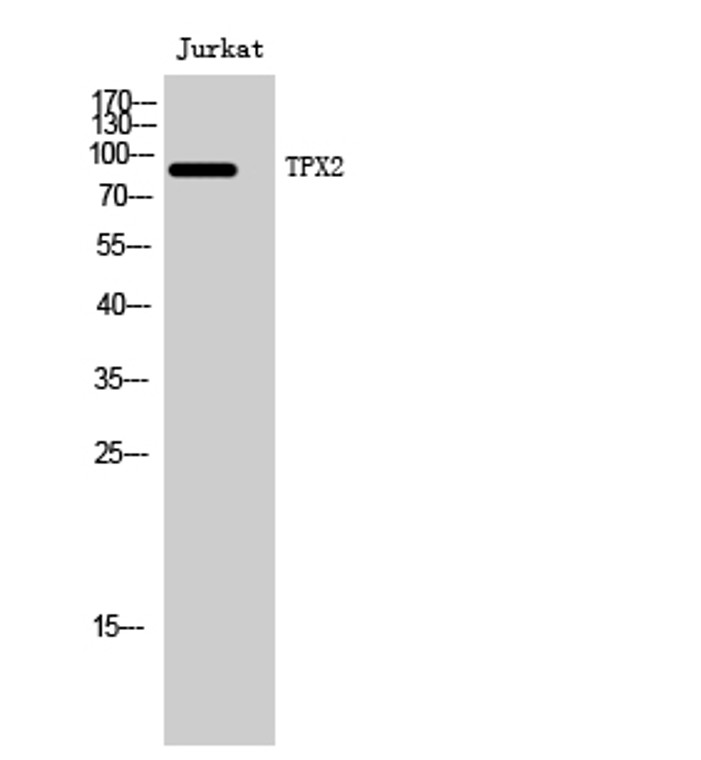| Host: |
Rabbit |
| Applications: |
WB/IHC/IF/ELISA |
| Reactivity: |
Human/Mouse |
| Note: |
STRICTLY FOR FURTHER SCIENTIFIC RESEARCH USE ONLY (RUO). MUST NOT TO BE USED IN DIAGNOSTIC OR THERAPEUTIC APPLICATIONS. |
| Short Description: |
Rabbit polyclonal antibody anti-Targeting protein for Xklp2 (301-350 aa) is suitable for use in Western Blot, Immunohistochemistry, Immunofluorescence and ELISA research applications. |
| Clonality: |
Polyclonal |
| Conjugation: |
Unconjugated |
| Isotype: |
IgG |
| Formulation: |
Liquid in PBS containing 50% Glycerol, 0.5% BSA and 0.02% Sodium Azide. |
| Purification: |
The antibody was affinity-purified from rabbit antiserum by affinity-chromatography using epitope-specific immunogen. |
| Concentration: |
1 mg/mL |
| Dilution Range: |
WB 1:500-1:2000IHC 1:100-1:300ELISA 1:10000IF 1:50-200 |
| Storage Instruction: |
Store at-20°C for up to 1 year from the date of receipt, and avoid repeat freeze-thaw cycles. |
| Gene Symbol: |
TPX2 |
| Gene ID: |
22974 |
| Uniprot ID: |
TPX2_HUMAN |
| Immunogen Region: |
301-350 aa |
| Specificity: |
TPX2 Polyclonal Antibody detects endogenous levels of TPX2 protein. |
| Immunogen: |
The antiserum was produced against synthesized peptide derived from the human DIL-2 at the amino acid range 301-350 |
| Function | Spindle assembly factor required for normal assembly of mitotic spindles. Required for normal assembly of microtubules during apoptosis. Required for chromatin and/or kinetochore dependent microtubule nucleation. Mediates AURKA localization to spindle microtubules. Activates AURKA by promoting its autophosphorylation at 'Thr-288' and protects this residue against dephosphorylation. TPX2 is inactivated upon binding to importin-alpha. At the onset of mitosis, GOLGA2 interacts with importin-alpha, liberating TPX2 from importin-alpha, allowing TPX2 to activates AURKA kinase and stimulates local microtubule nucleation. |
| Protein Name | Targeting Protein For Xklp2Differentially Expressed In Cancerous And Non-Cancerous Lung Cells 2Dil-2Hepatocellular Carcinoma-Associated Antigen 519Hepatocellular Carcinoma-Associated Antigen 90Protein Fls353Restricted Expression Proliferation-Associated Protein 100P100 |
| Database Links | Reactome: R-HSA-6804756Reactome: R-HSA-8854518 |
| Cellular Localisation | NucleusCytoplasmCytoskeletonSpindleSpindle PoleDuring Mitosis It Is Strictly Associated With The Spindle Pole And With The Mitotic SpindleWhereas During S And G2It Is Diffusely Distributed Throughout The NucleusIs Released From The Nucleus In Apoptotic Cells And Is Detected On Apoptotic Microtubules |
| Alternative Antibody Names | Anti-Targeting Protein For Xklp2 antibodyAnti-Differentially Expressed In Cancerous And Non-Cancerous Lung Cells 2 antibodyAnti-Dil-2 antibodyAnti-Hepatocellular Carcinoma-Associated Antigen 519 antibodyAnti-Hepatocellular Carcinoma-Associated Antigen 90 antibodyAnti-Protein Fls353 antibodyAnti-Restricted Expression Proliferation-Associated Protein 100 antibodyAnti-P100 antibodyAnti-TPX2 antibodyAnti-C20orf1 antibodyAnti-C20orf2 antibodyAnti-DIL2 antibodyAnti-HCA519 antibody |
Information sourced from Uniprot.org
12 months for antibodies. 6 months for ELISA Kits. Please see website T&Cs for further guidance










